Fri, 19 Jun 2020
Flora Tours
The Madeira flora consists of about 200 indigenous and naturalized species, of which 30% are endemic to Madeira and 10% are restricted to Macaronesia and if you are reading this I am sure you are already familiar with some of them, that you would like to observe.
We have an excellent tour for those who love plants and wish to learn and understand the botanical evolution and colonization of Madeira Island. This is the only botanical tour on the Island. This programme is fully dedicated to the Island’s unique plant communities, including exclusive and rare plants. You can book it here.
Where?
The programme starts on the warmer and dryer southern side of the Island and continues up mountain to the lush green northern slopes of S. Vicente valley and all the way to the a special spot at the Plateau.
So let’s start with some endemic plants you can find here.
Canary St. John's-wort- Hypericum canariense
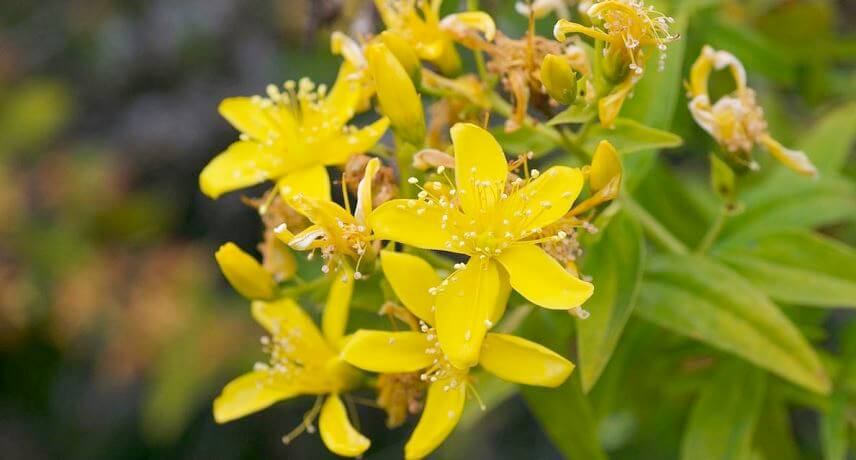
Photo: Kyrzysztof Ziarnek
Why is it called Hypericum canariense?
The genus name Hypericum is derived from the Greek ‘’hyper’’, meaning ‘’eikon’’, which is an icon or apparition. The species epithet ‘’canariense’’ means "of the Canary Islands", because it is endemic from there. The common name of St. Johnswort is from its association of St. John the Baptist.
What was it used for?
A long time ago people used to believe that this plant was able to protect them from evil spirits and that is why has been used in several Greek names such as Hyperion or Hyperides.
When does it bloom?
This plant blooms between May and September.
Laurel tree -Laurus novocanariensis

Photo: Ian & Clare Smith
What was it used for?
On the island of Madeira, the berries of Laurus novocanariensis are used to produce an oil, the "bay oil", used for medicinal purposes. This tree is applied externally in the treatment of skin infections, and works as an antirheumatic. Ingested for blood purification, stomatal and hemostatic action. Traditional medicine recommends using the oil to treat colds and other respiratory symptoms. The wood of this laurel, although not of high quality, was used in carpentry and in the construction of agricultural and kitchen utensils, such as wooden spoons.
Over the years, the leaves of this laurel were, and are still are, used the branches for skewers in the traditional "espetada".
When does it bloom?
November to April.
Where can it be found?
Ribeiro Frio, Fanal, Ecological park of Funchal.
Giant herb-Robert - Geranium maderense
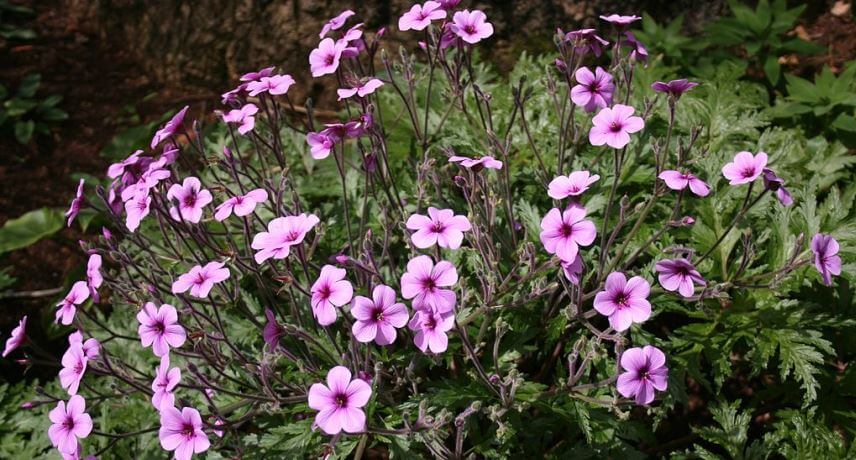
Photo: Hedwig Storch
Curiosities: The Madeiran Geranium (Geranium Maderense) or Madeira Cranesbill is native to Madeira and already it is recipiente of the prestigious Awards of garden Merit of the Royal Horticultural Society. The geranium is generally pest-free and it removes flowered stems and old leaves to encourage the production of fresh leaves and flowers.
When does it bloom?
March to December.
After flowering it releases the seeds and dies. The cycle is repeated in its natural environment or in a garden giving rise to new plants.
Where can it be found?
‘’Largo da tintureira’’ in Ribeiro Frio.
The Giant Buttercup - Ranunculus Cortusifolius
.jpg)
Photo: James Gaither
Curiosities: The giant buttercup is one of the largest and most impressive buttercups. Large, brilliant and golden yellow flowers reaching up to 5 centimeters in diameter.
When does it bloom?
It blooms from March untill at least May.
Pride of Madeira - Echium candicans
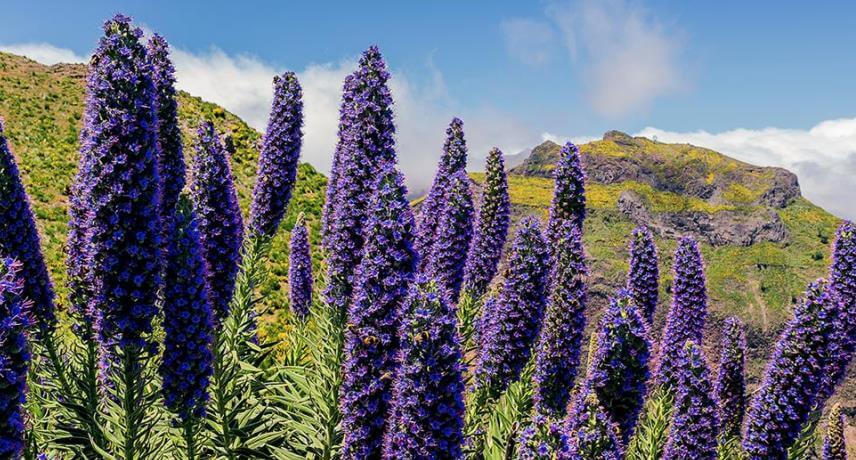
Curiosities: The Pride of Madeira (Echium Candicans) carries its name well as it is almost the island’s symbol. This plant, native to Madeira, flowers abundantly with powder blue and purple long conical flower bundles. Many butterflies adore the Pride of Madeira.
Where can it be found?
It only appears on the island of Madeira, usually appearing in the temperate and humid areas of the island, between 800–1400 m of altitude.
Broom heather – Erica platycodon
What was it used for?
Throughout the times and due to its extremely hard wood, it had several agricultural uses but also in sausages. It is used in the manufacture of brooms, fences and as firewood.
When does it bloom?
This plant blooms between April and June.
Where can it be found?
It is very common to find this species in Laurissilva forest areas for instance in ‘’Largo do Perado’’ in Ribeiro Frio Park, Chão das Feiteiras, Caldeirão Verde walk.
Fauna and Flora combined Tour:
This is the only Laurissilva rainforest tour on the Island fully dedicated to this biologically unique ecosystem.
We can see some animals, manly birds, butterflies, dragonflies, lichens and the many wonderful plants you can find in Laurelforest, here is some the highlights of the protected and endangered species we can find on the tour:
Madeiran Brimstone - Gonepteryx maderensis
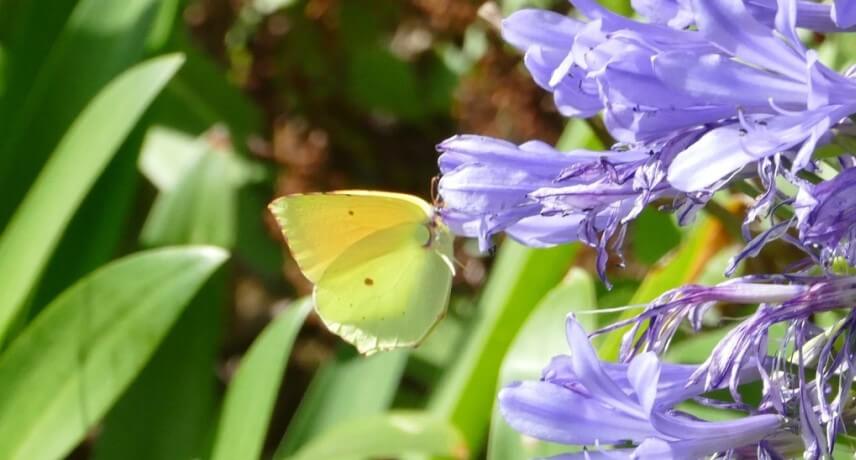
Photo: Martinswarren
Curiosities: This is an endemic spicies from Madeira. Males fore-wings are orange with thin yellow borders while females are more uniformly pale yellow. Occasionally, adults (males in particular) seek nectar from ?owering plants closer to the ground. Males may patrol over relatively large distances between areas of humid laurisilva, but females are more localised in their movements. Sometimes you still can find those flying in ‘’Avenida do Funchal’’.
Madeira firecrest - Regulus madeirensis
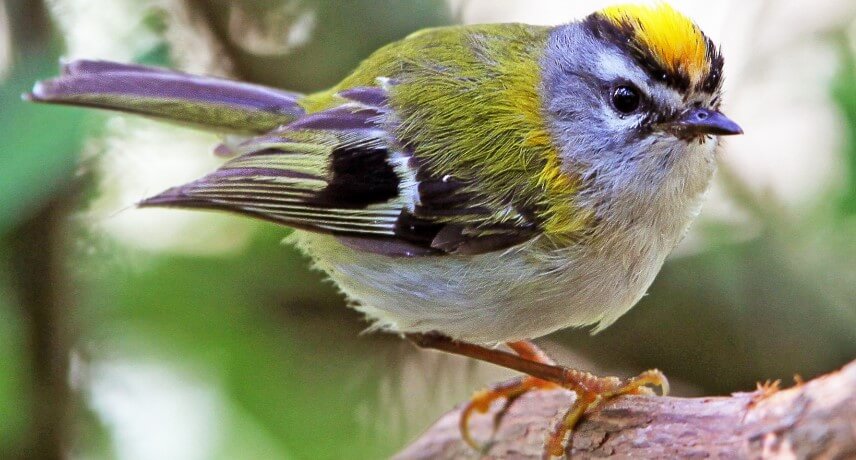
Photo: Christoph Moning
Curiosities: This is endemic species of Madeira easily identified by its orange crown stripe. It is the smallest bird of Madeira and Europe, it never stands still, it is always jumping or flying from one branch to another in the trees.
Diet: Takes tiny insects, which certainly gives it a high importance in terms of the balance of ecosystems, spiders and moth eggs from the foliage.
Habitat:This species can be found on the islands of Madeira and Porto Santo, preferably in high areas of heather. On the north coast of the island of Madeira can be found at lower altitudes.
Breeding: The presence and nesting of Bis-bis in Porto Santo occurs at Pico do Castelo, Serra de Fora and Pico da Gandaia. Builds hanging circular nests in bushes, using spider webs interwoven with small branches or moss.
Trocaz pigeon - Columba junoniae

Photo: Daniel Pettersson
Curiosities: This bird is one of the oldest specimens of the Macaronesia, which has a selective diet and partially depends on the fruits of several species of trees, being considered the sower of the Laurissilva trees.
Diet: Feeds on Laurel tree berries and on the leaves of several Madeira endemic bushes such as Teline maderensis.
Habitat: The Laurel Pigeon is a species that only exists on the island of Madeira, being more abundant on the North coast, still with some occurrences in small isolated areas of the South of the island.
Breeding: This Madeira endemic species builds its nest in small and discreet caves on the rocks or sometimes in trees and it lays a single egg in one or two annual broods and both parents participate in the incubation and feeding of the chick.
Tree heather - Erica arborea
What was it used for?
The wood, known as briar root, is extremely dense and heat-resistant, and is used for making smoking pipes. Leaf fossil atributed to this species were described for the Mio-Pleistocene deposit of São Jorge in Madeira Island. Locals use the branches of the Erica Arborea (only with permission) for building fences and for wind breaking. Most noteworthy, these windbreaks are used in vineyards along the roads.
Where to find it?
Assobiadores in Fanal, Feitas Chão da Ribeira in Seixal.
Til - Ocotea foetens

Photo: Hansueli Krapf
Why is it called Ocotea foetens?
Like the other species of the genus Ocotea, the til is rich in essential oils, which give an unpleasant odor to its wood (hence the name foetens, Latin for fetid).
What was it used for?
In the past, some agricultural and domestic tools were made with til wood, carved in thick trunks or branches, such as small mills, kneaders, bowls, vessels for wine growing, bathtubs, among others.
It was common to use this wood in the north and especially in Santana to build: the first mills, plows, the main parts of the looms, in the construction of the windmills and atafonas, more frequent in Porto Santo.
In the old days, the wood of the til (together with that of the heather) produced good charcoal, used by the sugar industry, at a time when there was no electricity and oil was not used as fuel.
In folk medicine, the infusion of til leaves is used in body washes, for itching (hives).
Where to find it?
25 Fountains Walk and Lakes of Madeira in Fanal, Levada do Rei in Santana.

